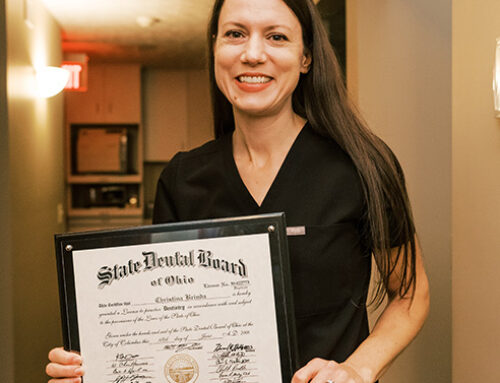If you have a dental implant, you might notice a small depression or hole in the gum tissue. You may notice this right where the implant crown meets the gum line. This feature is often a normal, intentional part of the implant design. However it can also be a sign of an issue needing attention. At Christina Brinda DDS in North Canton, we guide our patients through every aspect of implant maintenance. We ensure the longevity and health of their restored smiles. As your trusted North Canton Dentist and provider of advanced restorative solutions, Dr. Christina Brinda and her team explain what causes these spaces and their proper care.
The Expected Space: Access for the Implant Screw
The most common reason for a small hole in the gum or implant crown is related to the construction of the implant crown. Many implant systems use a screw retained crown. This crown has a small screw running through the center and down into the dental implant post to secure the restoration in place.
The Screw Access Channel
Dentists must create a channel in the top of the implant crown to access and tighten this screw.
Sealing the Channel
Once Dr. Christina Brinda tightens the screw, fills this access channel with a tooth colored restorative material.
Depression or Dimple
Over time, the sealing material over this access channel can slightly wear down or subtly depress. This can create a small, shallow indent or what may feel to you like a hole. This is generally normal and harmless if the implant feels stable and your gums are healthy.
The Unexpected Hole: A Sign of Potential Issues
While the screw access channel is a deliberate feature, a hole in the gums surrounding the implant or the crown itself can indicate an issue that requires immediate attention from your local family dentist.
Food Trapping
If the implant crown’s contours do not perfectly meet the gum tissue, a small space can form that traps food. This often happens due to the natural shrinking of the gum line. This so called food trap then looks like a hole and causes local irritation.
Cement Retention Failure
If your crown was cemented on the implant instead of screwed in, then, cement residue left under the gums can cause inflammation and swelling. This can lead to a pocket or hole like appearance as the gum tissue pulls away.
Peri-Implantitis
This condition is the leading cause of implant failure. It is a form of gum disease that affects the bone and gums surrounding the implant. Symptoms include redness, swelling, bleeding and sometimes the formation of a pocket. This pocket can feel like a “hole” where bacteria accumulate. It leads to bone loss and implant mobility.

Caring for the Area Around Your Implants In North Canton
To ensure the long term health of your dental implants and to manage the normal screw access channel, meticulous hygiene is non-negotiable.
Target the Base
Focus special attention on cleaning the area where the crown meets the gum line. This area requires different tools than a natural tooth.
Specialized Tools
We recommend using superfloss, interdental brushes, or a water flosser to effectively clean around the implant post and dislodge any trapped debris, including food that might accumulate in the screw channel depression.
Regular Check-ups
Regular visits to Christina Brinda DDS allow Dr. Brinda to monitor the health of the bone and soft tissue surrounding the implant using X-rays. She will check for signs of peri-implantitis or the need for a denture reline if you have an implant supported denture.
If you notice a sudden change, pain, or bleeding around your implant, contact us immediately. Early intervention is key to preserving your implant investment.
📞 Call our North Canton office today at (330) 498-0668 to schedule an appointment.

Ryan F.

Daniella S.
General Dentist Brinda is the best dentist I ever been to . If you’ve been holding off going to the dentist, whether for just cleaning or getting wisdom teeth out , go here . The staff is so welcoming and friendly and Dr. Brinda is so knowledgeable and walked me through every procedure from start to finish and all the expectations. She is a perfectionist that wants you to look your best and goes out of her way to do just that . I went in for a whitening treatment and cleaning and it was the best experience that I had at a dental practice! I definitely recommend this place to anyone looking to feel comfortable,well cared for and informed, while receiving best treatment for their smile.

Sorin B.
Dr. Brinda is hands down the best dentist I’ve ever been to! My wife and I live in Michigan and we make the drive every year to go see her because she’s that good! Whether it’s going in for cleaning/whitening or taking care of a cavity, I always have a great experience going here. I’ve never really enjoyed going to the doctor for anything, but I can honestly say I enjoy coming here for my yearly checkups. Dr. Brinda is very knowledgeable and extremely professional, and she goes out of her way to make people feel welcome and cared for. Highly highly recommend!

Ronald V.

Karen M.

David J.

Dan E.

Ms Lux
Dr. Brinda and her amazing office team are lovely; down to earth and outstandingly competent. Their main focus, I have no doubt from all of my visits, is their patient’s oral health. This team is professional and efficient, but also what we all want in a medical team of any sort, very knowledgeable. I truly appreciate all of the care and concern this office has offered me. This is truly a top notch team and one you can thoroughly entrust with your dental health. Thank you to you all.

Ty H.

Ty H.

Nathan C.

Angela P.

Leah K.

Sonya S.

Max P.

Jessica L.

Liv M.

Scott J.

Katherine G.

Calle S.

Beth S.

Tierra M.

Amy R.

Barbara F.

Katie M.

Myah W.

George M.

Barbara F.

Madison S.
I personally was shadowing Dr. Brinda's office for my Dental Hygienist Program, and it was an amazing experience! Dr.Brinda and her wonderful team are constantly working to make sure things are sterilized, wiped down, and organized for your visit! There was nobody sitting around, but everyone was helping other people out! Staff at Dr. Brinda's office was respectful, sweet and supportive! Dr. Brinda personally took time with patients, and treated them like a person, not just a patient. She asked recurring patients about an update on their personal lives from the patients last visit, and it was amazing to see the patients smile when she remembered. Overall, from someone who saw behind the scenes of this office, I would gladly come there to visit just to see the amazing work they do. I highly recommend Dr. Brinda's Office!

Rana Q.

Amy R.

Beth S.

Devin K.

Monica L.

Donald W.

Angela D.

Sebastian K.

Zara W.

Caleb M.

Amy S.

Matt W.

Chris L.

Efrain A.
My oldest started at 1 1/2 - 2 years old and now is 16. All are very happy with Dr. Brinda as well as the staff. Very caring and always explain what is going on when performing dental work beyond basic cleanings. Great attention to detail.

Susan R.
Dr. Brinda is friendly, caring and knowledgeable as are the staff. The atmosphere makes you feel at ease for any dental procedure.
Thanks to Dr. Brinda and all the staff.

Leah K.

Mark P.
I normally don’t make recommendations or write testimonials for services rendered. I expect and demand the highest patient care for my hard earned buck, period. I have been a patient for several years. Her team of professionals are exceeding my expectations regarding knowledge, kindness, skills, patient care, and my well being. Beginning from the initial phone call to schedule an appointment, through all of the facets of dental care provided, and processing the insurance payment, each employee earns a five star on my every visit.

Lauren S.
The most friendly staff I have ever seen in a dentist office! Dr Brinda was super knowledgeable about some underlying health conditions and my pregnancy and was super through and cautious! Say bye bye to any anxiety from dentistry work at this office it’s feels welcoming and homey and very clean.






